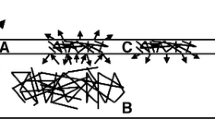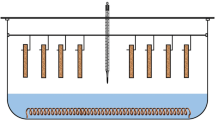Summary
An instrumental method for the measurement of the toxic value of preservatives against mould fungi on wood and wood products was tested as an alternative to the widely used visual method with its inherent disadvantage of subjectivity. The new criterion of effectiveness to be used was light reflectance as measured by either the Zeiss photometer (Leukometer) or the Zeiss spectrophotometer (Spekol 10) fitted with the Rd/0 reflectance adapter. Sodium pentachlorophenate and the WR-3 (quaternary ammonium compound), applied to pine and birch wood samples were tested for effectiveness against five species of fungi capable of causing surface moulding. Although the reflectance method was more laborious, the results obtained seem to be better than those obtained by the visual method. The proposed method appears to be of practical value in eliminating difficulties involved in the subjective assessment of both the intensity of surface growth and the effectiveness of the wood preservatives themselves.
Similar content being viewed by others
References
AS 1157.5-1971: Methods of testing materials for resistance to fungal growth. Part 5 — Resistance of timber to surface fungal growth. Standards Association of Australia, Sydney
AS 1157.1-1972: Methods of testing materials for resistance to fungal growth. Part 1 — General principles of testing. Standards Association of Australia, Sydney
British Standards Institution: BS 1982: 1968: Methods of test for fungal resistance of manufactured building materials made of or containing materials of organic origin. London: BSI
Courtois, H. 1961: Methodische Untersuchungen zur visuellen Beurteilung der Schimmelpilzresistenz. Marterialprüfung 3 (3): 104–109
CNS 49 0604. 1980: Wood protection. Methods of determination of biocidal properties of wood preservatives. U rad pro normalizaci a me reni. Praha
Ehlert, J.; Pantke, M. 1975: Ein Verfahren zur Prüfung der Wirksamkeit von Fungiziden in Dispersionsanstrichstoffen. Mat. Organ. 10 (2): 81–108
Feinst, W. C. 1977: Wood surface treatment to prevent extractive staining of paints. Forest Prod. J. 25 (5): 50–54
Garnier, G.; Magnoux, C. 1962: Protection des matériaux et matérials contre les principaux agents biologiques de dégradation. Corrosion et Anticorrosion 10 (1): 9–22, 10 (2): 47–57
GOST 24008-80. 1980: Wood preservatives. Method of testing resistance to blue stain and mould fungi. Gos. Komitet SSR pro Standartam, Moskwa
Grant, C. 1972: The use of a reflectance method for estimating surface mould growth on chipboard. Internat. Biodeterior. Bull. 8 (4): 139–140
Gray, V. R. 1961: The colour of wood and its changes. J. Inst. Wood Sci. 2 (8): 35–57
Haldenwanger, H. H. W. 1970: Biologische Zerstörung der makromolekularen Werkstoffe. Berlin, Heidelberg, New York: Springer
Höfert, H. J. 1959: Ein Filterphotometer zur Remissionsmessung. Z. f. Instrumentenkunde 67: 118–124
Japanese Standards Association: JIS Z 2911. 1960: Methods of testing fungal resistance. Tokyo (Reaffirment 1966): ISA
Kerner-Gang, W. 1965: Versuche zur Auswahl geeigneter Pilze für die Prüfung der Schimmelwiderstandsfähigkeiten von Werkstoffen. Mat. Organ. 1 (1): 35–74
Kollmann, F.; Malmquist, L. 1952: Untersuchungen über die Trocknung von Kiefernschnittholz mit erhöhten Temperaturen. Swedish Forest Products Research Laboratory, Medd. 23, Stockholm
Land, C. J.; Banhidi, Z. G.; Albertsson, A. C. 1985: Surface discoloring and blue staining by cold-tolerant filamentous fungi on outdoor softwood in Sweden. Material and Organismen 20 (2): 133–156
Loos, W. E.; Coppock, W. A. 1964: Measuring wood color with precision. Forest Prod. J. 14 (2): 85–86
Lutomski, K.; Splawa-Neyman, S. 1976: Preliminary results of investigations on screening test of chemical compounds suitable for the preservation of lignocellulosic materials against biodeterioration. Intern. Res. Group on Wood Pres. Document No. IRG/WP/262
Morgan, J. w. W.; Orsler, R. J. 1968: The chemistry of colour changes in wood. 1. The significance of stilbens. Holzforschung 22 (1): 11–16
Nakamura, G.; Takackio, H. 1960: Reflection of light and surface roughness on sanded surface of wood. J. Japan Wood Res. Soc. 6 (6): 237–242
Norton, R. 1960: Brightness and nature of colouring materials in wood. TAPPI 43: 826–831
NF T 72-083. 1976: Produits de protection de la surface du bois. Méthode d'essai de résistance aux microorganismes. Paris: AFNOR
Schmidt, O.; Kerner-Gang, W. 1986: Natural materials. In: Rehm, H. J.; Reed, G. (Eds.): Biotechnology, Vol. 8. 557–582. Weinheim: VCH Verlagsgesellschaft
Schneider, A. 1986: Der Einfluß von Wärmebehandlungen im Temperaturbereich bis 200° und von Wasserlagerung bis 100° auf den spektralen Remissionsgrad verschiedener Hölzer. Holz Roh-Werkstoff 24 (11): 542–545
Schneider, A. 1970: Beiträge zur Dimensionsstabilisierung des Holzes mit Polyäthylenglykol. 2. Mitt. Untersuchungen über Eigenschaftsänderungen des Holzes durch Tränkung mit Polyäthylenglykol und über die Wirksamkeit verschiedener Tränkverfahren. Holz Roh-Werkstoff 28 (1): 20–34
Seehann, G.; Liese, W.; Kess, B. 1975: List of fungi in soft-rot tests. Intern. Res. Group on Wood Pres. Doc. No. IRG/WP/105
Shibamoto, T.; Inoase, Y.; Kenyo, Y. 1960: studies on water-borne wood preservatives. Part 17/18: Color change of wood treated with colorans caused weathering. J. Japan Wood Res. Soc. 6 (3, 4): 128–151
STAS 8022-67. 1967: Wood determination of antifungal properties. Bucuresti: Oficiul da stat pentru standarde
Stenius, A. S. (1969): The ELREPHO in the pulp and paper industry. Stockholm: Swedish Forest Products Research Laboratorium Medd. 42
Strzelczyk, S.; Lamprecht, S. 1972: Studies on the blue-staining of pine wood. Acta Mycologica 8 (1): 239–247
Theden, G. 1959: Der Begriff der Widerstandsfähigkeit gegen Schimmel. Materialprüfung 1 (5): 175–176
Voronina, K. I.; Nazarova, O. N. 1980: Resistance of artistic paints to fungi and new method for protection against biodeterioration. Chudothestviennoye Nasledstvie 36 (6): 131–144
Ważny, J. 1970: Studies on the occurrence of soft-rod of wood in Poland. Zeszyty Naukowe SGGW — Lesnictwo: No. 14
Ważny, J. 1974: Preliminary studies on the technique of the appraisal of effectiveness of wood preservation against mould. Zeszyty Naukowe Akademii Rolniczej w Warszawie-Lesnictwo, No. 20: 53–62
Ważny, J. 1986: Moderne Klassifikation der Biodegradationsfaktoren von Holz. Sesja Naukowa z Okazji 35-lecia Studiow Technologii Drewna w Poznaniu
Ważny, J.; Rudniewski, P. 1970: Investigations on the resistance of paint bindings against the attack of microorganisms. Biblioteka Muzealnicktwa i Ochrony Zabytkow, Ser. B, No. 27: 102–108
Ważny, J.; Rudniewski, P. 1972: The biodeterioration of binding materials used in artistic painting. Mat. Organ. 7 (2): 81–92
Wolf, F.; Liese, W. 1977: Zur Bedeutung von Schimmelpilzen für die Holzqualität. Holz Roh-Werkstoff 35 (2): 53–57
Author information
Authors and Affiliations
Additional information
Paper sponsored by the State Enterprise of Conservation of Fine Arts Objects, Warszawa ul. Zielna 3
The authors thank Dr. J. D. Thornton, CSIRO Division of Forestry and Forest Products, Highett, Australia, for kindly correcting the English text of this paper
Rights and permissions
About this article
Cite this article
Ważny, J., Rudniewski, P., Krajewski, K.J. et al. The reflectance method for testing the effectiveness of fungicides against surface mould growth on materials: I. Wood. Wood Sci. Technol. 23, 179–189 (1989). https://doi.org/10.1007/BF00350940
Received:
Issue Date:
DOI: https://doi.org/10.1007/BF00350940




